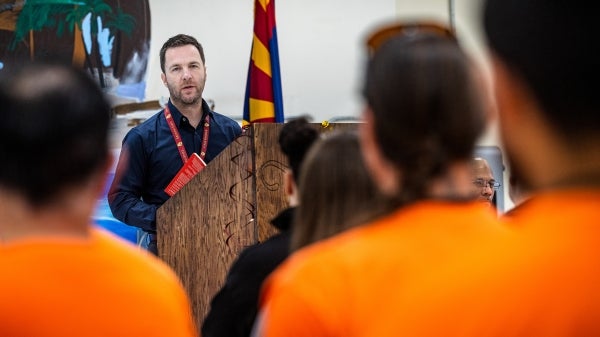New ASU research finds that some security measures make students feel less safe in their schools

New research by an Arizona State University professor shows that some methods of addressing security in schools may actually make students feel less safe.
A new paper by Sarah Lindstrom Johnson, an assistant professor in the T. Denny Sanford School of Social and Family Dynamics, showed that high numbers of security cameras inside schools were associated with students having lower feelings of safety as well as lower feelings of support and equity at their school.
“The big take-home to this is that there may be a cost to these security measures if they are not done well,” said Lindstrom Johnson, a former high school teacher in Baltimore who studies school environments and how they affect student learning.
Interestingly, the study found differences between white and black students’ perceptions. The black students viewed the security cameras inside school less negatively than their white peers. The researchersBesides Lindstrom Johnson, the research team included Jessika Bottiani and Catherine Bradshaw, both of the University of Virginia, and Tracy Waasdorp of Johns Hopkins University. hypothesized that the black students might see the cameras as a way of documenting what happens to them.
“To some extent they might see it as protective,” she said. Black students made up about 29 percent of the survey sample.
Sarah Lindstrom Johnson
The findings come as states consider increasing security measures in the wake of several school shootings over the past year. The National Conference of State Legislatures reports that 87 bills were passed nationwide to address school safety this year.
The study, published in the Journal of Adolescent Health, included more than 54,000 students in 98 middle and high schools in Maryland who answered surveys as well as independent assessments of the school physical environment including security measures.
Lindstrom Johnson and the team measuredThe environment was measured using the School Assessment for Environmental Typology, or SAfETy, a tool that Lindstrom Johnson co-developed. She is now working on making that instrument available to schools on a smartphone app. three kinds of security: outdoor cameras, indoor cameras and security personnel. Then they measured students’ perceptions of their schools in three areas: safety, support and equity. For the purposes of the study, security personnel were defined as anyone in a uniform, but Lindstrom Johnson said that she knows most of them were sworn law officers.
“We made a distinction between inside and outside cameras and found that the perceptions operated entirely differently, which is something that no one has ever shown before,” she said.
“High levels of cameras inside the school were negatively related to students’ perception of safety, students’ perception of support and their perception of equity.”
Lindstrom Johnson said that it’s likely students see indoor cameras, typically deployed in the entrances, hallways, stairwells and cafeterias but not in the classrooms, as a surveillance measure to monitor misbehavior, like cutting class, and as a way to get them in trouble.
Outdoor cameras were positively related to support, but had no positive or negative association with safety or equity in the students’ eyes.
The presence of security personnel was positively related to safety among students, she said.
“There’s a lot more work to do around these findings with security officers, including unpacking their role in school discipline, what weapons are they carrying, and their training in working with adolescents,” said Lindstrom Johnson, who added that Arizona is one of a few states nationwide to have state-level programs to train school resource officers.
Previous studies to understand the impact of school security measures have found mixed results, she said, and are typically based on self-reporting of security measures by students or school administrators. Her research is one of the few studies that objectively measure security measures. The team started the research in 2015 but decided to delay publication until they could add more schools, to ensure that these important findings were accurate.
The main message is that school administrators should carefully weigh how they spend resources for keeping students safe, she said.
“This work suggests that cameras outside the school and security officers might improve students' feelings of safety and support, but we also have a body of research that shows that evidence-based mental health resources in schools are effective,” she said. “They might be effective in reducing school-rampage shootings — that evidence is hard to come across — but we know they’re effective in reducing student behavior problems and improving student academic outcomes.
“If you’re asking me what do I put my money into to make schools safer, it’s around supporting students’ mental health.”
Top image by Pixabay
More Arts, humanities and education
Autism diagnosis leads ASU professor to write book about neurodiversity and literature
Bradley Irish always knew his mind worked differently.But it wasn’t until two years ago that Irish, an associate professor in Arizona State University’s Department of English, discovered why.He was…

ASU professor, Arizona inmate work to rehabilitate the 'imprisoned mind'
An Arizona State University professor has collaborated with an Arizona inmate on a book that examines why investing in healing prisoners would benefit everyone.“Imprisoned Minds: Lost Boys, Trapped…
Illuminating legacy at ASU
In 2020, the ASU Art Museum unveiled a groundbreaking installation, "Point Cloud (ASU)," by renowned artist Leo Villareal. The art piece was given a permanent home on the Tempe campus in 2024 thanks…
